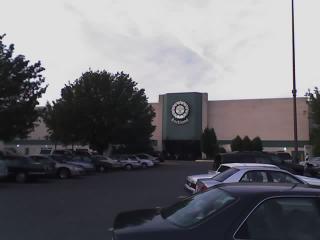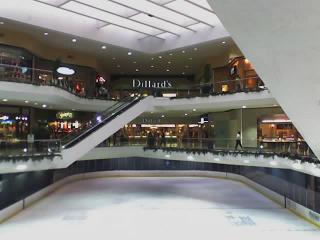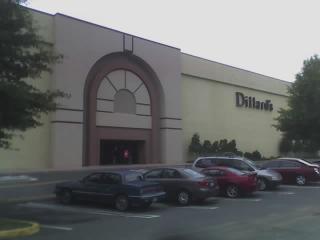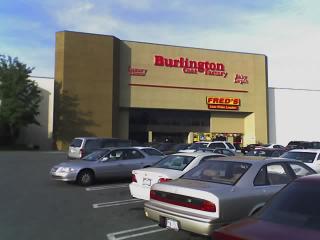 By J. Lee Howard
By J. Lee HowardCharlotte Business Journal
Eastland Mall is for sale -- exactly two years after an Ohio real estate investment trust bought the 1.1 million-square-foot retail center and promised a $10 million makeover.
Columbus, Ohio-based Glimcher Realty Trust has bundled Eastland with two other Southeast shopping malls in a portfolio and is marketing the properties for sale.
Some observers say the proposed sale could mark the beginning of the end for the Charlotte region's fifth-largest shopping center, which opened in 1975.
"But that doesn't mean it couldn't reinvent itself," says local land-use consultant Walter Fields of the Walter Fields Group. "The stores could be re-tenanted. Markets change, and retailers change with the markets."
Officials at publicly traded Glimcher won't comment, and they decline to identify the brokerage firms the company has hired to market the three malls.
The other malls are East Pointe Plaza in Columbia, S.C., and Pea Ridge Shopping Center in Huntington, W.Va.
Glimcher disclosed its intentions in a recent filing with the Securities and Exchange Commission.
The possibility of new ownership makes Eastland's future an open question, local observers say. They note Glimcher had committed to work with the city to transform the property into a village center for Charlotte's east side.
Glimcher had teamed with the city, neighborhood residents and area business interests on a plan to redevelop the site, with the proposal including a transit hub for streetcars.
City officials say Glimcher representatives have said privately the company will continue its plans to upgrade the mall until a buyer is found. The question, of course, is whether a new owner will follow through on Glimcher's promises.
"From my conversations with the company, they plan to continue their efforts to redevelop the property, because if they can't get the price they're looking for, they don't want to lose time for redeveloping and repositioning the center," says Tom Flynn, assistant to the city manager for business relations.
He remains optimistic, noting Glimcher has continued talks with the Charlotte Area Transit System about CATS' buying a 2-acre mall parcel for a transit stop.
"We are glad they are going to continue their repositioning work," Flynn says. "If they had not, it would not have been good for the center or the east side."
 A shifting market
A shifting marketIn August 2003, Glimcher took full ownership of the mall, buying the 80% stake held by The Cameron Group of Charlotte and Florida-based Hospitality International Group for $4.75 million. Before that deal, Glimcher held 20% interest in Eastland.
Shortly thereafter, the company announced plans to recast the mall to accommodate the east side's shifting demographics, which include burgeoning Asian and Latino populations.
The idea was to create a walkable town center with entertainment venues, shops and dining. The city kicked in $3 million from its Eastside Strategy fund to further leverage the makeover.
Among the plan's enthusiastic supporters was District 5 Councilwoman Nancy Carter, who represents the area.
Carter's belief in a vibrant future for the site hasn't wavered. If a new owner doesn't initially buy into the city's plans for the site, she contends, pressure can be brought to bear to make it reconsider. "We have the density here to make this a true town center," Carter says. "This mall has the potential to be transformed."
Market watchers say Eastland's viability as a traditional mall is drawing to a close. Competition from newer malls, they say, eventually will draw away the anchors -- Belk, Dillard's and Sears. Officials at those companies did not return phone calls seeking comment.
Some view the major threat as Childress Klein Properties' 1.2 million-square-foot Bridges at Mint Hill, planned for Lawyers Road at Interstate 485.
Chris Thomas, Childress Klein's retail partner, disagrees. He notes the Bridges project is more than 10 miles from Eastland and contends that development is more likely to draw shoppers from Union and Cabarrus counties than from Charlotte's interior.
Still, he acknowledges the Eastland area is a changing market and any new owner is going to have to recognize that. "There are still dollars to be spent over there," Thomas says. "Eastland is a viable retail location. It's just a matter of finding out which retailers will be successful there."
 Mid-1970s magnet
Mid-1970s magnet The 30-year-old Eastland Mall once was a commercial magnet, buoyed by suburban growth and unique attractions such as its indoor skating rink.
But through the years, Eastland hasn't remade itself the way SouthPark mall has. SouthPark opened five years before Eastland but remains a high-end retail hub that bears scant resemblance to its initial 1970 operation.
Meanwhile, the east-side demographics have shifted, and the enclosed mall as a concept has generally faded in popularity.
Several real estate sources say Glimcher officials previously talked privately about clearing the 30-acre Eastland site altogether and starting from scratch, possibly making it a discount retail power center.
"The big retailers want to be in higher-growth areas, and Eastland is bound in with no interstates nearby," says Andy Misiaveg, a partner at retail brokerage firm The Shopping Center Group. "Whoever buys it is going to have to be satisfied they can do something with it long term, without the current retail lineup."
In recent years, Eastland has lost key tenants, both within the mall and along its perimeter.
 J.C. Penney, which closed three years ago, has been replaced by discount retailer Fred's Inc. and a Burlington Coat Factory. Across Albemarle Road, the former Upton's department store has sat empty for years. Other, smaller retailers also have closed or moved.
J.C. Penney, which closed three years ago, has been replaced by discount retailer Fred's Inc. and a Burlington Coat Factory. Across Albemarle Road, the former Upton's department store has sat empty for years. Other, smaller retailers also have closed or moved.Weighing new uses
In June 2003, the city adopted a growth strategy for the area called the Eastland Area Plan. As part of that plan, it created a group called the Eastland Area Strategy Team, a coalition of residents, business owners and other interested parties wishing to help shape the area's future.
Most residents and businesses are aware the mall's clientele and surrounding neighborhoods are changing, says Kyle Woudstra, a senior associate at WGM Design Inc. and co-chair of EAST.
"Eastland Mall as a regional mall is no more," Woudstra says. The trick now, he says, is to make the best use of the land for future generations.
It may well be the property could be revamped to accommodate higher-density housing or other uses, he says. But major retail development "is not going to work on this site anymore."
The key may be to retool Eastland to cater to the area's growing ethnic populations, says Rich Barta, partner at retail brokerage and development firm Core Properties.
A Spanish language movie theater and stores catering to a variety of ethnic tastes could do well, he suggests.
"But redeveloping it as another 1 million-square-foot mall would be ill-fated," Barta says. "It would be like turning an apple into an orange."
All of our malls seem to be "reinventing" themselves. The Tacoma Mall has become a Simon Mall, Southcenter Mall, has become Westfield (or is it Westerfield?)Shopping Center, and The Sea-Tac Mall, which never seemed very successful in my opinion has become "The Commons at Federal Way"
ReplyDeleteThe Tacoma Mall and South Center Mall seem to have benefited from the change. They seem ritzier now, and South Center has the Rainforest Cafe now, which is really cool. "The Commons" just seems ridiculous though. When you say "The Commons" no one knows what you are talking about. I used to work at that mall though, and it was never busy. I worked at South Center as well, which was always crazy busy, and by comparison, Sea-Tac was dead.
I am sad to hear about malls closing or being unsuccessful, because it makes me think of all the people in the community, and how they are apparently not thriving, because they can't go shopping. The thing is though, some people just hate malls. My parents never go to the mall. I go, but often don't purchase. I like The Super Mall, which is an outlet mall.
By the way, don't you think that someone who was dangerous would be the one who would say "I'm safe as milk?" No one would say "I'm as dangerous as PCP" if he were really dangerous. In fact if someone said, "I'm dangerous" I'd have to laugh at him.
Good point on the "safe as milk" claim Marrie. How safe is milk really? What if Steven here really means "I'm as safe as milk served to lactose intolerant individual" or "I'm as safe as milk a year past its expiration date."
ReplyDeleteYou got a mean streak that's not completing that sentence? (I highly doubt it =)
~Carrie =)
Good points, ladies :-)
ReplyDeleteI engage in some risky behavior (a little drinking mostly) but overall I'm the kind of guy who you can trust to stick around when the going gets tough, and not the sort of person who'd, say, jump out of a plane on a whim. Though I wouldn't rule it out; I'd just have to be really, really sure the parachute worked if I did. LOL
The mall that this entry is about needs some reinvention and fast. Its neighborhood has shifted from mostly middle-class whites to low-to-middle income blacks and Latinos, and with the changes, most of the old stores have left, and the remaining ones aren't trying very hard.
We had an active discussion on this place on UrbanPlanet for a while, with some of the less progressive people saying it should be torn down, and the more progessive types seeing that with a little reinvention, it could be viable again.
We're seeing two kinds of malls emerge from the fall of the department store indsutry. The ritzy luxury mall and the really ghetto mall, with fewer and fewer malls in-between. Tacoma Mall and Southcenter seem to be haeded in this first direction, and Eastland and Sea-Tac are headed the other way.
I say there's still room in the middle, and creating the ideal middle market mall will involve a lot of different and new ideas to grab that consumer. Putting in discount stores, entertainment, community meeting places, streetscapes, that sort of thing. Eastland needs this desperately and hopefully someone will make sure it gets it eventually. Apparently it won't be the owners that have it now though :(
The issue of declining malls will continue to face many communities in this country in the years ahead.
ReplyDeleteMany enclosed super-regional malls from the 1970's, considered state of the art in their prime, were not designed to be adaptable and are suffering as a result. Not only have the demographics of their market areas changed, but the retail business has evolved, along with consumer tastes. As Marrie says, many people "hate" malls, but far more simply prefer "town center" designs that seem more urbane and appeal to our idealized view of life before suburbia. Enclosed malls aren't being built anymore - even in Phoenix! Eastland and its contemporaries are quickly becoming relics and are destined to be redeveloped.
These mall sites hold tremendous potential - not only for a new type of "middle market" retail centers you advocate, but also for housing, offices, public facilities, and community gathering places. Victor Gruen, who designed Southdale, became the leading critic of enclosed malls by the early 1970's, lambasting them as "monofunctional" centers. The best urban places in history are home to a large mix of uses and users, and I believe the development of malls like Eastland were an aberration in the history of American cities that cannot be sustained. Gruen would be pleased to see the recent fall of the building type he helped bring into existence.
Communities will certainly benefit from the redevelopment of these dinosaurs into more traditional urban environments. The challenge is to be conscientious and creative in doing so, creating mixed-use districts that will thrive for far longer than the malls they replace.
Also, it's great (and funny) that Marrie latched onto your "safe as milk" claim. She's very insightful, read her blog.
ReplyDeleteI think every person can be "as safe as milk" and as "dangerous as PCP" at times. The nature of our existence cannot be adequately summed up in a few paragraphs of a Web Site. It is very difficult for a person to give an accurate description of himself or herself.
Mitch is my advocate, thanks Mitch.
ReplyDeleteThe Sea-Tac Mall, or I guess I should say, with my nose up in the air, "The Commons" has closed down the Mervyns and replaced it with a Target. I guess it is trying to appeal to people who don't like the ritzy places, but then, why the name change? It is just bizzare to me, Federal Way as a city seems to be trying to become a clone of Bellevue or Kirkland, and then their mall becomes "The Commons" Do they mean it is a place for "common folk" to shop? Or is it a place with lots of shops in common? Or is it a place for people to congregate, like we all own the commons? I don't know why it bothers me so much. I do know that Federal Way, where I used to live, has become my least favorite place. The traffic is a nightmare and the atmosphere seems to be always striving, or something.
Mitch: Maybe I'm safe as PCP-laden milk :-)
ReplyDeleteAlthough I think town center designs are just as big a fad as the malls they're replacing, I agree with many of your points on the malls of the '70s being outmoded retail destinations, especially in areas like the one Eastland is in.
Eastland came about as a way to provide shopping for the east end of Charlotte and was spearheaded by the Belk department store company, which anchors the mall, if not for much longer.
Belk was trying to evolve into a full-line chain not unlike Macy's in the '70s, and its landlocked flagship downtown Charlotte store wouldn't allow it to do so. So Belk partnered with a developer and developed this tract in east Charlotte that was cheap and on a main thoroughfare, but unfortunately not anywhere near an interstate.
That is probaly Eastland's biggest flaw as a regional mall. Belk was so eager to build a new store that it jumped the gun and picked a horrible spot that never was able to sustain itself after newer malls came on board.
That area still needs shopping, but that mall will likely have to be drastically changed to provide what the neighborhood needs.
Marrie: I think it's supposed to be like a "common meeting place" or a village green with stores.
I also think part of the reason for the name change is that 'Sea-Tac Mall' is a rather uninspired name. As the mall has never been terribly successful from your description, it's probably a way for the developers to get a new start with a fresh name.
I think I would have picked something different, maybe Sea-Tac Town Center. Seems warmer.